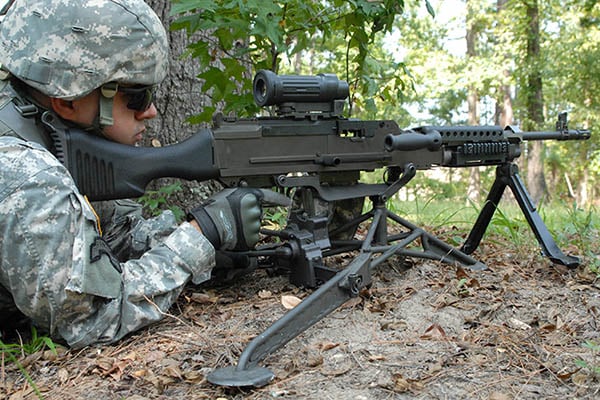
Last Updated on
The United Kingdom and New Zealand are adopting the 7.62mm version of the FN Minimi. Other countries already making use of the 5.56 Minimi’s big brother are the the Australian Defense Force as the F89 Maximi, USSOCOM as the Mk. 48, the Spanish Navy and Polish Special Forces. As debates rage over potentially adopting an intermediate do-all cartridge, such as the 6.8 SPC, a number of militaries have decided to up the power ante by going with the already-adopted .30 caliber NATO round.
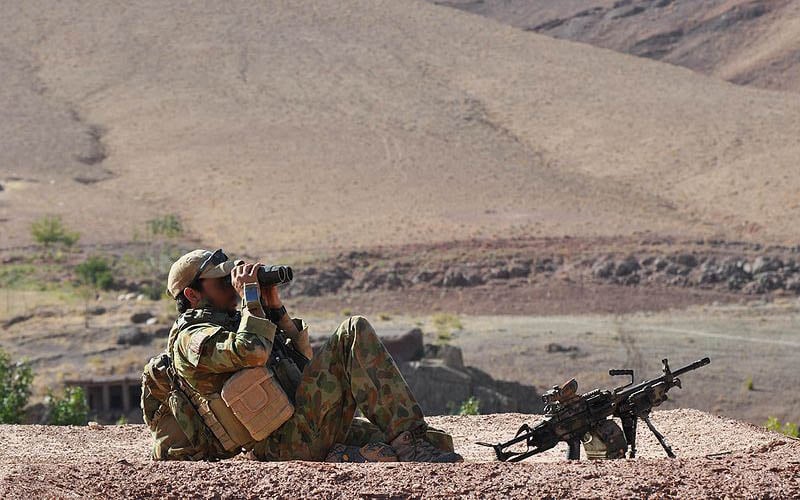
History
Fabrique Nationale Mitrailleuse d’Appui General, (general purpose machine gun, or GPMG) was designed by FN engineer Ernest Vervier and has been in production since 1958, hence the name FN MAG 58. Prior to this Mr. Vervier also assisted with the design of the Belgian company’s most venerable designs, such as the Fusil Automatique Léger (Light Automatic Rifle) or FAL rifle, and the Minimi (known as the M249 to US troops) in 5.56.
This fabulous GPMG is a mainstay of more than 80 countries and replaced the US M60 in that role. The problem is, like the M60, with a heavy base weight without ammo or accessories a belt-fed weapon is unwieldy for an individual. The 5.56 Minimi, designed by Fabrique Nationale (FN) in Herstal and released in 1974, is a light machine gun chambered in 5.56x45mm. As with any true machine gun, it is capable of sustained fire and features a quick change barrel, belt feed, and fires from an open bolt to facilitate this. As issued in the US, the M249 has been pressed into automatic and light machine gun roles. Other militiaries do likewise, such as the Australians (F89) and the British (L110.)
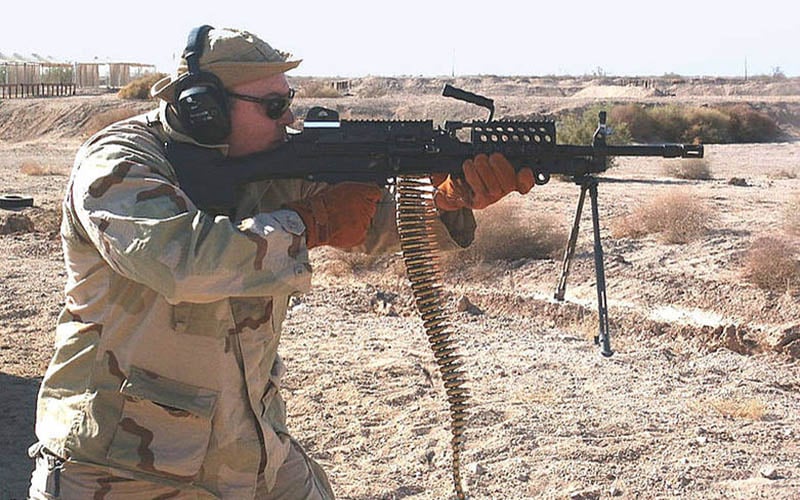
A standard Minimi tips the scale at 17 pounds unloaded but even with a full 200 round drum weighs less than an unloaded M240 or M60. The stated problem is power, or lack there of. Some elements desire something that combines the Minimi’s lighter weight with more punch. It turns out the original Minimi prototype was first designed to be chambered in 7.62x51mm NATO and later built around the 5.56 mm. Just over a decade ago USSOCOM (United States Special Operations COMmand) created specs for their first Mk 48 and FN started developing around their original Minimi prototype. Testing yielded positive results and FN Herstal officially released the 7.62 Minimi.
Basic Design And Variants
The Minimi 7.62 is very similar to current 5.56 models, incorporating a quick change barrel, non-adjustable, self-regulating gas system and a hydraulic recoil buffer in the buttstock. Included iron sights are calibrated for 7.62 from 100 to 1000 meters in 100 meter increments and a Picatinny rail on the top cover accepts a variety of optics. This bigger version serves the same role as its little brother, primarily being an automatic rifle or automatic weapon carried by an individual or pintle mounting on a vehicle while remaining capable of serving as a true machine gun when mounted with a traverse and elevation mechanism.
The system is belt fed, air cooled and gas operated with the piston under the barrel and a rotating locking bolt. The weapon uses the same disintegrating 7.62mm belts as current 7.62 NATO machine guns and can be fed from a clip-on 100 round combat pouch. There is no magazine feed. FN offers two base models, the Standard and TR (Triple Rail), weighing about 18 pounds with the TR offering three rails in place of the standard handguard. Both models can be had with an adjustable stock adding ¾ pound.
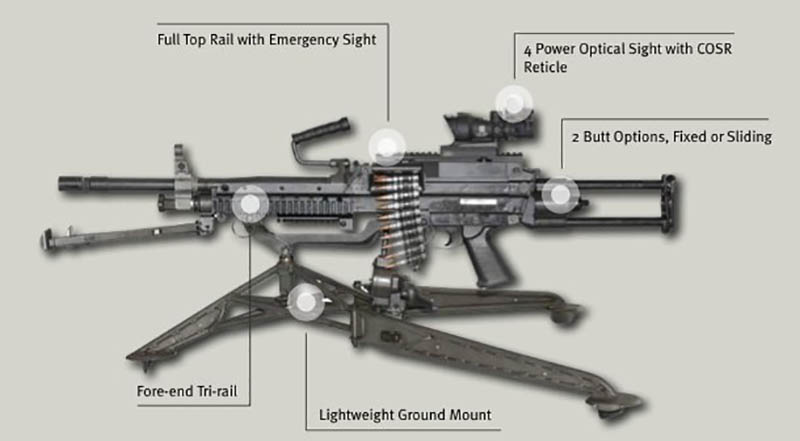
The main US versions are the Mk48 manufactured by Fabrique Nationale Manufacturing, Inc., a division of FN Herstal based in Columbia, South Carolina which also produces the M16, M249 and M240. USSOCOM approved the Mission Need Statement/Operational Requirements Document for a new 7.62×51mm NATO lightweight machine gun to replace the Mk 43 (M60E4) as used by Naval Special Warfare Command units and FN began manufacture in March 2003.
The Mk.48 mod. 0 is little more than a scaled M249 and more than five pounds lighter than the M240. There is a large amount of parts commonality between the Mk48, M249 and the older Mk46 machine guns, easing maintenance. This version is currently serving with the Navy SEALs and Army Rangers. The Mod 1 variant is a product improvement with better receiver pins, vented handguard and a new gas block.
New Zealand is issuing two versions as the 7.62 LSW Minimi and replacing their current 5.56 mm LSW C9 with it. They’ve ordered 360 of the CAT A version and intend it for maneuvering units. It comes equipped with FN’s Triple Rail, a 4×32 ACOG featuring a COSR (Common Optical Sight Reticle) and Micro red dot for CQB, a combat light, 100 round pouches and emergency sight in rail along with the M192 Light Weight Ground Mount (tripod with integral T&E) for ground machine gun use. The CAT B version is a stripped down FN Standard version intended for training and support units.
The M192 Tripod
Gunnery skills with machine guns are more akin to artillery than small arms. Used properly, crew-served weapons can command whole sections of terrain. However, this takes more thought and coordination than randomly spewing out lead. Spraying bullets “like a garden hose” and annihilating everything with a wave of the muzzle is a myth.
Outside of the Commonwealth militaries (Great Britain, Australia, Canada, etc.) few modern troops learn gunnery with machine guns. Most qualification courses fail to address gunnery concepts (even if personnel are held to published qualification standards) and such weapons are issued out with no training or preparation beyond learning basic maintenance and loading/unloading procedure. Crew selection is directed by whomever has been selected to carry the thing (which, for some reason, tends to be the smaller personnel in the squad…) With the exception of school-trained Machine Gun Gunners, such as Military Occupational Specialty 0331 in the Marine Corps or similar course, there are shockingly-few formally-trained personnel in the US military that fully understand this.
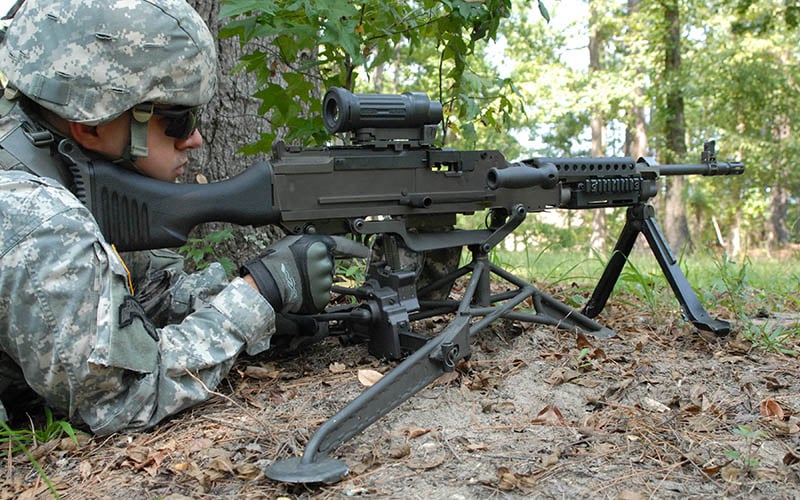
Gunnery requires control. A tripod is what distinguishes a machine gun from an automatic rifle or other full auto weapon. The Traverse and Elevation mechanism offers repeatable, precise adjustments allowing the gunner to quickly direct accurate fires in even increments. Where an automatic rifle has to be realigned for each burst, a gunner can quickly traverse an area, moving the beaten zone uniformly while ensuring no gaps in coverage. In a way, machine gun gunnery is about T&E and tripod use.
In the World War One era, heavy machine guns were fixed even though they fired the same cartridge as light machine guns. To provide sustained fire, heavy MGs of the day required water cooling and used cumbersome tripods. World War Two saw the rise of machine guns capable of sustained fire while remaining somewhat portable. Christened General Purpose Machine Guns and characterized by the German MG34 and 42, these weapons maneuvered as well as previous light machine guns while remaining effective when emplaced. Technology has allowed effective tripods to become lighter still.
Taking construction hints from modern motorcycle manufacture, the M192 is a light weight, foldable ground mount with integrated T&E mechanism. It is two-thirds the weight of the previous M122 and compact enough to fit inside the current issue barrel bag. Instead of hand wheels to control traversing and searching adjustments, the M192 uses two levers. Pushing the levers up or down moves in even five mil increments. For quicker, bold adjustments, the levers can be pulled out or pushed in, allowing the mechanism to slip freely in any direction.
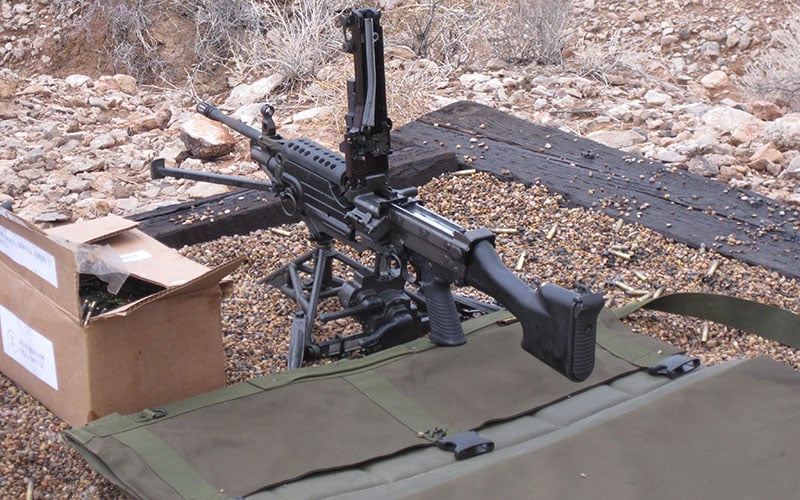
As with anything new, old hands will grumble. Common complaints typically focus on the integral T&E because it doesn’t work like the hand wheels and personnel unfamiliar with how this is supposed to work claim it doesn’t track smoothly. The first issue is maintenance. The included Technical Manual and instructions that nobody bothers to read clearly state the mechanism needs to be flushed out, drained, and relubricated prior to first use and periodically thereafter. The second issue is a misunderstanding of what the T&E is for. The mechanism should be used like the carriage return on an old manual typewriter. Press the lever fully and firmly, then completely release. Each full press moves in 4-5 mil increments, which is normally an ideal amount of traverse, i.e., a “Two Inch Tap.” If the lay needs to be moved more than 10 mils (two presses), pull the lever(s) all the way out and slip the mechanism. I find twisting both levers like the throttle on a motorcycle effectively disengages both of them simultaneously. Completely releasing the levers automatically reengages the mechanism.
Conclusion
Does this indicate a trend for more militaries returning to the 7.62 at the squad and team level? Despite the jump to 5.56 for individual weapons, NATO has continued to maintain .30 caliber machine guns for vehicle and support use, as seen with the MAG 58. The additional power and reach 7.62 has is undeniable, making it a better choice when the extra weight can be handled with a gun crew or in a vehicle. It’s been argued that a single intermediate round would serve better as this alleviates the supply burden of maintaining different cartridges but that requires a consensus that hasn’t been achieved.
The USMC pushed for and got their M27 Infantry Automatic Rifle – a magazine-only, HK-based automatic rifle – because they felt an open bolt, belt fed system was too clumsy in this role. The British L86A1 LSW, Soviet RPK, Chinese QBB-95, and other automatic rifles are still issued for the same reasons. Some maintain that only a belt fed weapon will provide the needed volume of fire. This is certainly true for machine gun and most automatic weapon use but not necessarily for automatic riflemen maneuvering with a squad and needing to maintain fires for the duration of an engagement.
Note that special operations requirements can be different than this. A small team that is compromised may be forced to use something like a peel back to break contact. Such a tactic is essentially a ruse, with the smaller element trying to sound like a much larger force for a short period while conducting a controlled withdrawal. There is no intent to fix and flank enemy positions with such a tactic as the team simply wants out of there. This will require a greater volume of fire immediately available even if it can’t be maintained long enough to support a counter attack, which works well enough here because such a compromised small team isn’t actually intending to do so. For this, belt fed weapons can be ideal and the Minimi is about as light and convenient as they come. Now, re-engineered to take 7.62 rounds, it’s louder and hits harder, too.




Comments (1)
Ryan Bsays:
July 8, 2018 at 9:36 pm“In the World War One era, heavy machine guns were fixed even though they fired the same cartridge as light machine guns. To provide sustained fire, heavy MGs of the day required water cooling and used cumbersome tripods. World War Two saw the rise of machine guns capable of sustained fire while remaining somewhat portable. Christened General Purpose Machine Guns and characterized by the German MG34 and 42, these weapons maneuvered as well as previous light machine guns while remaining effective when emplaced. Technology has allowed effective tripods to become lighter still.”
You forgot the Lewis gun mang. Brit commonwealth made like 3x more of those than HMG’s, and they were super portable and gave especially Australian troops a huge edge over the hun <3. great article btw